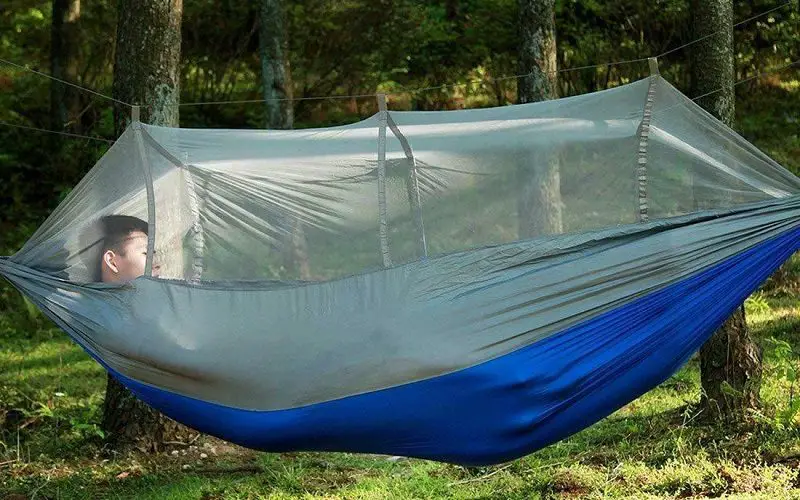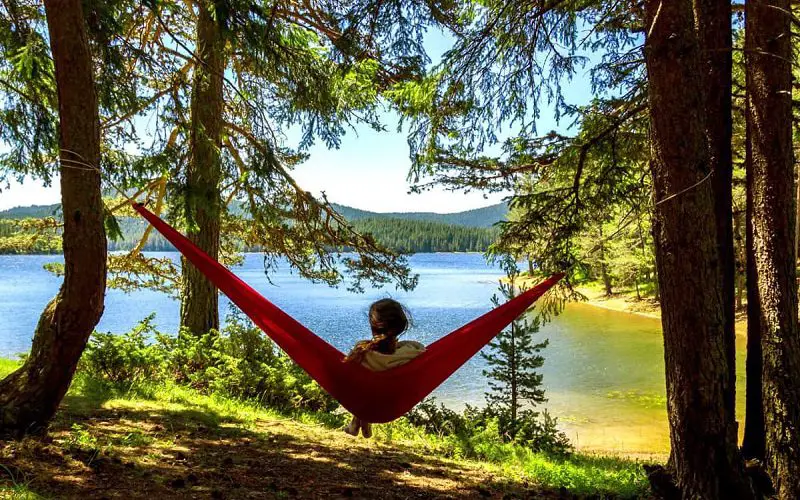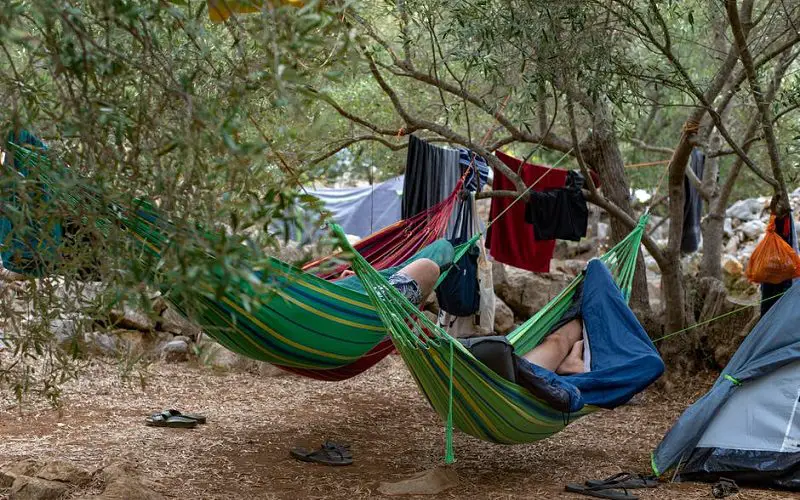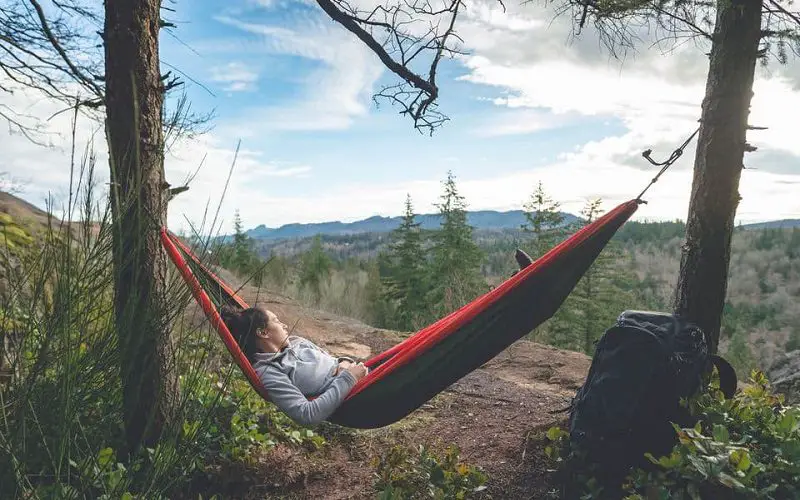Although hammock camping has been popular for decades, it was relatively uncommon until recently. The trend toward hammock camping really took off as the ultimate lightweight shelter option.
Now campers and backpackers of all types are ditching their tents for hammocks and finding that they’ve never slept better.
Many hammock aficionados will be quick to tell newcomers that sleeping in a hammock is incredibly comfortable, and the setup process really isn’t any more difficult than a tent.
But first-time hammock campers who don’t take the time to familiarize themselves with their new equipment may end up frustrated and swear off hammock camping for good.
10 Hammock Camping Tips
Make your first hammock trip go smoothly and really understand firsthand why so many outdoor enthusiasts are switching to this unique style of shelter.
1. Choose a Hammock Designed for Camping

An absolute rule of thumb for hammock camping that will literally make or break your first camping trip is to invest in a high-quality hammock specifically designed for camping.
Even though you may already have a hammock swinging in your backyard, don’t assume it will function comfortably or safely on the trail.
Hammocks designed for casual summer catnaps aren’t durable enough for hammock camping, and they are rarely comfortable for a full night’s sleep.
When we talk about investing in a high-quality hammock, we don’t mean you need to spend hundreds on the latest model. Since you’re new to hammock camping, there’s no reason to spend big bucks on a tent until you’re absolutely sure you’ll stick with it.
In addition to a well-made hammock, you’ll also need to invest in a durable, waterproof tarp for hanging over it.
2. Invest in an Underquilt
Swaying in a hammock, suspended in the air, is a very peaceful feeling, but it also means that staying warm is a bit trickier.
In a hammock, you won’t have the natural insulation of solid ground beneath you, unlike sleeping in a sleeping bag on a pad in a tent. This means you’ll have to take some extra steps to keep warm compared to what you would do with a tent, especially in the winter.
Every seasoned hammock camper will recommend that after purchasing the hammock and shelter gear, newcomers also purchase an underquilt. An underquilt is an insulted quilt that hangs beneath the hammock and provides a buffer against the cold temperature underneath you.
Some are specially designed to envelope the hammock, and some even extend up the sides for additional insulation. Underquilts come in a variety of thicknesses and R-values, similar to tent quilts and down apparel.
They also come in different lengths, including half-length and full-length. Underquilts do cost a bit more since they are essentially large, insulated blankets.
Chances are, if you’re experimenting with hammock camping for the first time, you’re likely going during the summer or otherwise warm weather. If that’s the case, you may be able to do away with an underquilt until you’re ready to invest in one.
In a pinch, you can also use a sleeping pad between you and the hammock, though this does take up space and can be uncomfortable or slippery.
3. Always Pack a Bug Net

As mentioned, you’re probably going to go hammock camping for the first time in warm weather. And with warm weather comes the bane of all outdoor enthusiasts—insects.
Whether it’s mosquitoes, tiny flies, or any other form of insect, bugs are not only annoying, but they can also leave painful bites, transfer disease, and cause other health issues.
Most tents come with some sort of bugproof mesh, but if you don’t protect yourself, hammocks will expose you to insects.
Bug nets are an absolute must for camping during any time of the year when bugs are out. There are a few different types of bug nets you can use for hammock camping.
You can either purchase a few years of mosquito net or No-See-Um mesh and make your own, or you can buy a large net and drape it over the hammock. Another option is to purchase a bug net specifically designed for hammocks.
4. Practice Hanging Your Hammock
Always practice hanging your hammock before you actually leave for your trip. This will test out all your gear and help you get the perfect pitch the first time once you’re out on your camping trip.
You’ll want to use wide webbing straps designed for hammocks that hang around tree trunks. Choose straps made of a low-stretch material, such as polyester, although any strapping designed for hammock camping should be suitable.
As you attach and adjust your hammock, check the angle of your suspension lines (the lines connecting your hammock to the tree strap).
These lines should be roughly at a 30° angle. When looking at your hammock, it should have a deep sag. This sag will allow you to lay properly in the hammock and not fall out of it as you move during the night.
We really encourage new hammock campers to sleep out in their hammock at home in their backyard before going on their first trip.
This really gives you a chance to work out the kinks before you’re actually out in the woods.
5. Learn to Lay in Your Hammock

Hammock campers always praise how comfortable sleeping in a hammock is, but if you try to lay in it straight, you might end up with a sore back.
One of the most common complaints of disappointed first-time hammock campers was that they couldn’t sleep well and woke up feeling stiff. Learning how to properly lay in a hammock is the trick to getting the “sleeping like a baby” rest you hear people talk about.
The key to sleeping in a hammock is to lie at a diagonal angle rather than straight, with your feet slightly higher than your upperbody. When you lay straight, you end up sleeping with a curve in your back. By laying diagonally, you’re able to keep your back and legs at a comfortable level.
After your first few nights in a hammock, you’ll automatically know what angle to lay at to feel most comfortable. If you’re still experiencing difficulties, consider adjusting the pitch of your hammock.
If you are too taut, you won’t be able to lay at an angle, and if you are too slack, your body will become bent like a banana. While you’re practicing hanging your hammock (Tip 4), also be sure you hop in, lay down for a bit, and experiment with angles.
Eventually, you’ll know exactly how to hang your hammock to give you the best night’s sleep.
6. Use Mummy-Style Sleeping Bags
Some hammock campers use camping quilts in place of a sleeping bag, but we find that new hammock campers will probably feel more comfortable with a sleeping bag.
Many dedicated hammock campers find that sleeping bags offer more warmth than quilts, plus there’s the chance you already have a sleeping bag at home that will work.
Rectangular sleeping bags and pads won’t fit well in a hammock. They’ll take up precious space, making you feel a bit claustrophobic, and they could even physically prevent you from sleeping at a proper angle.
A better option is to use mummy-style sleeping bags and pads. Mummy sleeping bags will keep you much more comfortable and able to lay at a diagonal, like you’ll need to do.
They’ll also take up less space in the hammock while still keeping you every bit as warm. Sleeping pads also come in mummy shapes, although a rectangular slim cut might work if you already have one at home.
Some hammock campers simply purchase a basic rectangular, solid foam sleeping pad and cut it to shape themselves.
7. Bring Travel Pillows

Some folks can sleep quite peacefully with nothing but a sweater balled up as a makeshift pillow, but we do encourage new hammock campers to bring at least one travel or camping pillow with them on their first few trips.
Camping pillows will help you adjust to sleeping in a hammock by assisting you in finding a comfortable position.
Sleeping diagonally does take practice, but many hammock campers find that a pillow does the trick perfectly. Bringing a small second pillow can also be handy for knee support.
Many new hammock campers tend to find that their knees may feel a bit sore as they get used to laying properly in a hammock. Placing a small pillow under or between the knees quickly resolves this issue.
You can also use a ball-up jacket for the same purpose in the event you’re already out camping and find your knees uncomfortable.
8. Include a Water Break in Your Lines
The suspension systems used with hammocks vary between manufacturers and individuals, but one important little accessory to include is a water break or drip line.
Many hammock suspension systems will have a carabiner or something specific to hammock camping, such as a Dutch Biner. These will serve as a water break, but not as well as a drip line.
A drip line is nothing more than a small piece of line or paracord tied to the hammock’s suspension line, either before or after the carabiner.
This piece of line will probably cost you nothing since you likely already have some type of line around your home or garage that will work. In return, you’ll have proper protection from rain running down into your hammock.
9. Select Your Hanging Spot Carefully

Since your hammock will keep you above the ground, it’s easy to think that choosing a camping site isn’t as important as a tent.
This isn’t correct, and you should be just as careful with your choice of hanging spot as you would with a tent.
To make leveling easier, look for an area with flat ground. You’ll also want to make sure there aren’t any rocks, branches, or potentially harmful objects located under your hammock.
It’s very rare that a properly suspended hammock will break, but if it does, you don’t want to land on anything that will hurt you.
With that idea in mind, never suspend hammocks over one another, as you sometimes see in photo ops. If the top hammock falls, it is extremely dangerous to both hammock occupants.
Examine the trees from above before choosing a spot. Never hang your hammock under dead trees or live trees with dead tops or branches. If you’re ever in doubt, choose a different spot.
10. Position Your Hang Properly
If you position a properly set-up hammock, it should fare well in the wind.
If you get to the campsite and find that it’s windy, there are two options: either select a different site or strategically position your hammock as best as possible.
Look for natural landscape features around the campsite that you can use as a windbreak, such as a small grove of trees.
When doing so, keep the advice in Tip 9 in mind, especially when it comes to making sure the trees in the grove are healthy with no dead limbs overhead.
In addition to looking for a natural windbreak, if you have no option but to set up camp, you’ll want to position your hammock with the long side perpendicular to the wind.
If you position it parallel, the wind will blow up your hammock’s tarp like a balloon, and you’ll end up cold. We also recommend purchasing a good pair of tarp stakes or tent stakes if you already have any.
These really help keep the sides of your tarp down.
Give Hammock Camping a Try
Hammock camping tips can seem intimidating at first, but in reality, it’s no more complicated than tent camping.
In fact, once you get the hang of hammock camping, you’ll find that you’re able to carry less gear and set up your shelter faster than if you were using a tent.
With time, you’ll learn exactly how you like to hang your hammock and be able to sleep even more soundly than before.
In no time, you’ll be able to grab your hammock and go camping without a second thought, just like you would with your tent.